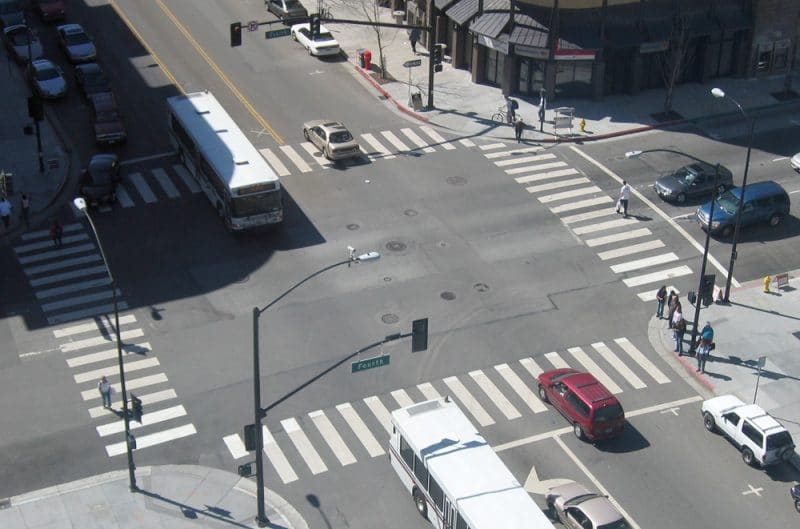One of the most common road features is an intersection. Even those who live in smaller towns are aware of intersections and the dangers involved in using them. An intersection (defined by Cambridge) is simply “the place where two or more roads join or cross each other.” While the government has developed various resources for vehicles approaching intersections; such as stoplights, double white lines, crossing signals, and light poles; there are some times when these said resources fail to keep individuals safe. This failure to keep individuals safe isn’t the fault of the intersection resources, instead, it’s usually the fault of an individual who either knowingly or unknowingly decides to not keep the rules of the intersection resources. It is for these reasons many accidents occur at intersections. While it is hard to detail any accident, there are some prominent reasons why accidents occur within intersections. There are also multiple suggestions drivers should consider when approaching an intersection to avoid accidents and keep everyone safe.
Table of Contents
Intersection Accidents
Why do so many accidents occur at intersections? The National Highway Traffic Safety Administration reports an estimated 36% of all related crashes to occur at intersections. These crashes tend to happen as cars constantly come into conflict with each other. There are various ways in which cars can come into conflict with each other such as:
- Cars making right-hand turns: This can occur whether the light is green or red, creating a constant flow of cars going in several different directions.
- Cars continuing straight: It is determinate upon the car to stop at light signals; if they do not stop, conflicts can occur.
- Cars making left-hand turns: Depending on the state, cars are eligible to make left-hand turns as soon as traffic has cleared, or they have to yield to oncoming traffic. Some states require cars to only turn left when they have a green arrow. The state of Utah lets cars turn once they have yielded to oncoming traffic, or they have a green arrow light.
Many of these conflicts happen on a daily basis and don’t end up being conflicts at all, simply as road-to-road interactions. Maybe this is why intersection accidents can become more apparent. Due to moving traffic, paying attention is not just on you, the other vehicles involved must also pay attention to everyone’s actions to avoid an accident. NHTSA calls these incidences “illegal maneuvers” or “inattention” that usually factors into accidents.
It is always important to pay extra or special attention at intersections. Many times drivers get into a set routine and forget to pay attention or even the basic attention they need on the road. We all remember what it was like when we first started driving- most of us incurred a deep sense of attention to nearly every movement on behalf of our vehicle. As time goes by, we get into our routine taking the same way to work or school every day. With the use of technology today there is a higher rate of distracted driving paired with this routine of laziness, which can create a particularly harmful car accident.
Intersection Accidents by the Numbers
A study done by the National Highway Traffic Safety Administration showed several prominent statistics between intersection accidents and other outlying factors. In their report, they stated nearly 97% of intersection crashes involved drivers not paying attention; compared to 3% of crashes in which other factors such as weather conditions caused the accident. Many of the accidents at intersections are also caused by “obstructed views” on behalf of the drivers or times in which the driver could not fully see oncoming traffic or other hazards entering the intersection.
Interestingly enough, different ages create different reasons for intersection crashes, most of which have little hazards. In consideration to traffic signals, those twenty-four years or younger caused crashes at intersections that were attributed to distraction within the car, aggressive driving conditions on behalf of the driver, inability to gauge other drivers, or external distractions. Those who were twenty-five to fifty-four years old caused intersection accidents due to lack of performance, illegal maneuvers, inattention, or too fast/aggressive driving conditions. Those fifty-four years and older caused crashes based on a misjudgment of speed, obstructed views, or inadequate surveillance.
This report stated that both males and females provided the same statistics concerning the reasons for crashes; however, males did have a higher occurrence of specific accidents versus females. Males showed a higher occurrence for non-performance errors, illegal maneuvers, incorrect speed assumptions, aggression, or distracted driving. Females have a higher occurrence of inattention, irregular assumptions on behalf of other drivers, and internal distractions.
Intersection Safety
While every intersection is different, there are two general types of intersections: those with signals and those without signals. The Federal Highway Administration has come up with guidelines drivers should be aware of both at intersections with signals and intersections without signals. While some of these guidelines are internal improvements they would like to make, there are many improvements which the driver themselves can make both at intersections with signals and intersections without signals.
Intersections with signals:
- Traffic control awareness: Drivers need to be aware of the different traffic controls that they encounter each and every day. Signals such as traffic lights need to always be paid attention to. White lines have usually been painted to warn the driver of where they need to stop. If a driver crosses this line, it could put other cars, themselves, or even pedestrians in danger.
- Operational awareness: Intersections are the perfect place for cars to start, slow down, or speed up. Depending on the signal color, cars may be adjusting their speed and starting and stopping fairly quickly. Drivers need to be aware and pay attention to these constantly changing conditions.
- Awareness of other cars: Cars will travel in several different directions. It is hard to account for all cars, but it is better to be safer than sorry. Take the extra time to look for other cars. Give yourself plenty of time to start or stop at intersections or in traffic.
- Improve driver compliance: Drivers must be willing to adhere to all driving directions and laws at each intersection. Some intersections may have different guidelines, such as signs stating the inability to turn right or left. In Utah, the most common signs are the inability to turn left at certain signals.
Intersections without signals:
- Improve sight distance: When you are going to turn, make sure you leave yourself enough distance to turn but most of all to see oncoming traffic. If you are unable to see oncoming traffic at all (this may happen due to an oncoming truck or other vehicles) do not assume the route is clear.
- Improve gap awareness: Many times cars are approaching quickly from other directions; being aware and more cautious of the normal gaps in between cars could help the driver in making decisions whether they be the ability to go straight or turning.
- Improve general driver awareness: Being as aware as you possibly can be is always a good policy to keep. You will never be able to understand what other drivers are doing, so be alert.
- Obey traffic laws: Laws are in place for good reasons. Always remember the laws and if in doubt, look for signs so you don’t put yourself in a position of causing or being involved in an accident. If there is oncoming traffic you must yield the right-of-way to them. If you go when it is not your turn or you do not have the right-of-way, you may cause a severe accident.
- Reduce operating speeds: Speed always plays a factor in driving and the severity of accidents. It is important to slow down and take the time to maneuver your car safely and with the right amount of control to not get in an accident.
Contact Us
If you have been injured at an intersection due to someone else’s negligence, please do not hesitate to contact us at Christensen & Hymas for a free consultation. Each consultation is confidential and seeks to give you the information you need to make a good decision. Many accidents do not have clear-cut “at-fault” guidelines, and many times the insurance companies can go back and forth on your settlement. Call our office at 801-506-0800 to get the advice you need and the justice or compensation you deserve for your pain and suffering.

